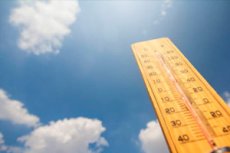New publications
Heat hits emergency room visits, cold hits deaths: New look at climate and health
Last reviewed: 09.08.2025

All iLive content is medically reviewed or fact checked to ensure as much factual accuracy as possible.
We have strict sourcing guidelines and only link to reputable media sites, academic research institutions and, whenever possible, medically peer reviewed studies. Note that the numbers in parentheses ([1], [2], etc.) are clickable links to these studies.
If you feel that any of our content is inaccurate, out-of-date, or otherwise questionable, please select it and press Ctrl + Enter.

Scientists led by Carlos Gould at the University of California, San Diego, and Stanford University published the largest analysis to date of temperature and health outcomes in California. They looked at 2006–2017 data on 3.2 million deaths, 45 million emergency department (ED) visits, and 22 million hospitalizations, and compared them with daily highs and lows in 2,626 ZIP codes.
Key Results
1. Mortality and cold
- Excess mortality: On cold days (below the optimal temperature range of 17–24 °C), mortality increases cumulatively - by 5–7% for each additional degree below 10 °C.
- Age effect: in people ≥ 65 years old, cold peaks increase mortality by up to 12%, while in young people (< 45 years old) the increase does not exceed 2%.
- Causes of death: cold weather accounts for the increase in deaths from cardiovascular diseases (up to +10% at -5 °C) and respiratory diseases (+8%).
2. Disease and heat
ED visits: Every +5°C above the optimum results in a 20–25% increase in ER visits.
Categories of requests: the strongest growth was recorded in
- exacerbation of chronic diseases (asthma, COPD) - +30%
- heat stroke and dehydration - +50%
- non-infarction chest pain and arrhythmia - +15%.
Hospitalizations: Heat is associated with a slight (up to +5%) increase in hospitalizations, but the ED bears the brunt of the burden.
3. Projections for 2070–2099
Using RCP4.5 climate models and population projections, the authors estimated:
- Cold-related mortality will decrease by 15–20% due to a reduction in the number of extremely cold days.
- Heat-related ED visits will increase by 34,000–45,000 cases per year (at RCP4.5), increasing the healthcare burden by 12–15% of current volumes.
Mechanisms and social context
- Physiology: cold constricts blood vessels, increases blood pressure and blood clotting, while heat provokes dehydration, electrolyte imbalance and weakening of thermoregulation.
- Inequality: Poor neighborhoods have fewer air conditioners and cold shelters, and their ED visit rate at 5°C is twice that of wealthier communities.
Authors' comments
“Most studies focus on mortality, but our work shows that heat creates a significant burden of disease that is not reflected in death statistics,” says Carlos Gould.
"When planning for climate change adaptation, it is important to consider that the decline in cold-related mortality is accompanied by a sharp increase in heat-related emergency room visits," adds Stanford's Lauren Barnes.
Practical conclusions
- Adapting emergency care systems: increasing staffing and resources for predicted heat waves.
- Development of "shelters" (cooled shelters) and expansion of heat warning programs.
- Focus on vulnerable groups: The elderly and people living in poor areas need targeted protection measures during extreme temperatures.
This paper proposes to rethink approaches to assessing climate impacts on health by including not only loss of life but also the health burden on hospital services and the loss of quality of life due to heat-induced exacerbations of disease.
